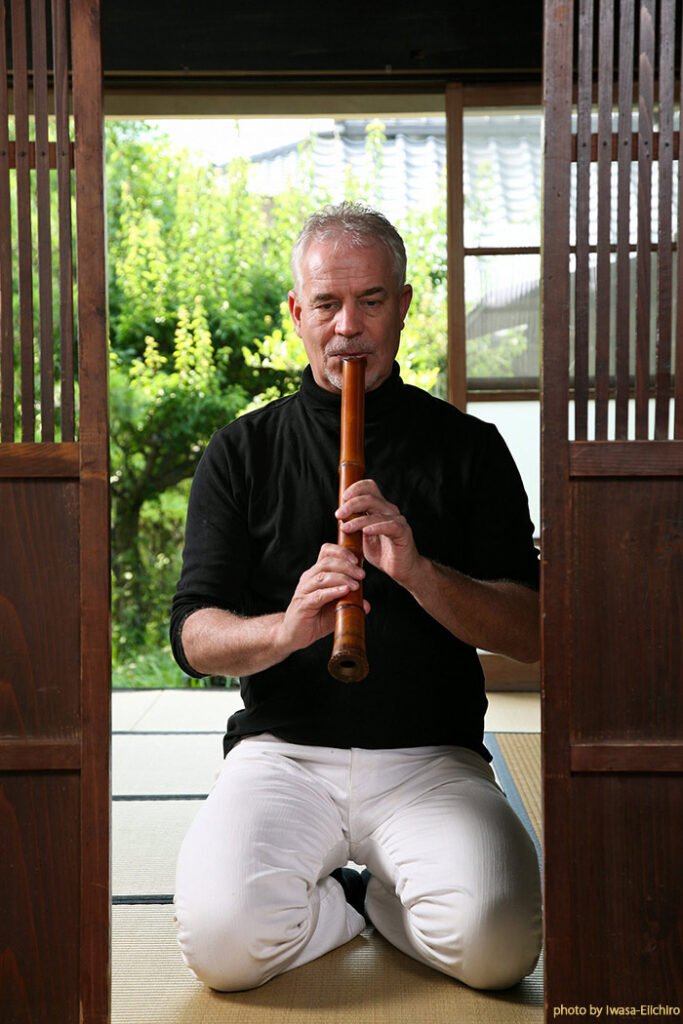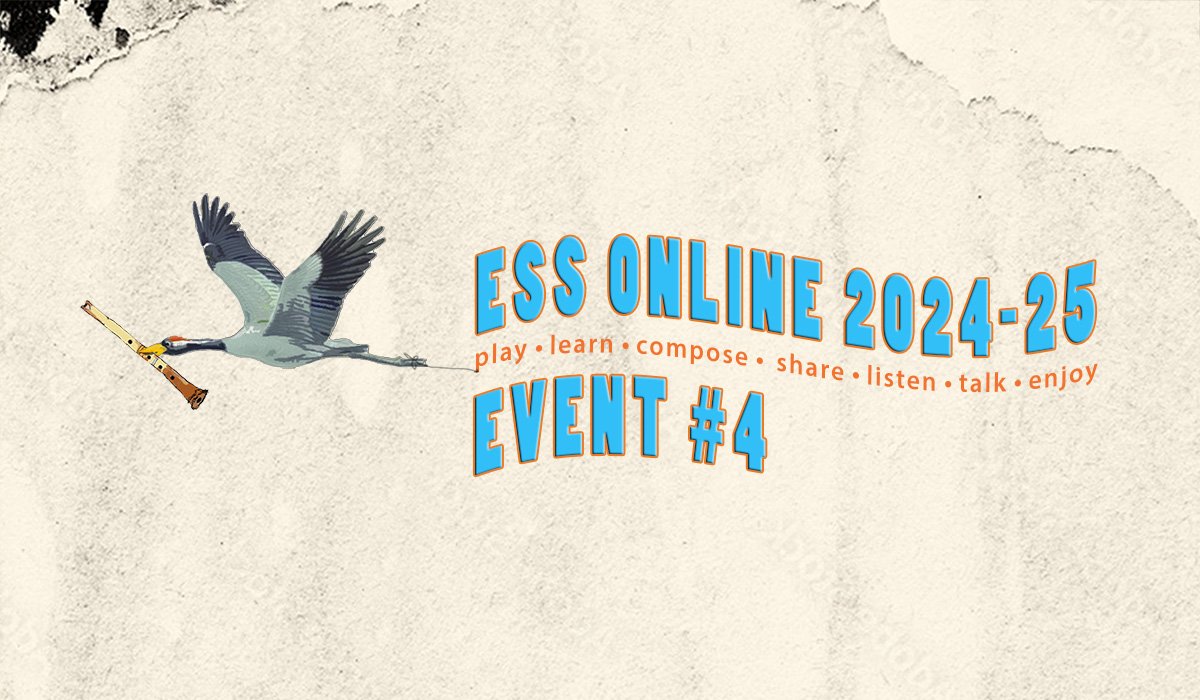SCHEDULE & CONTENT
EVENT#4
Intermediate/Advanced
with Zenyoji Keisuke, Christopher Yohmei Blasdel, Martha Reika Fabrique, Jean-François Suizan Lagrost
SATURDAY 15 FEBRUARY 2025
| Session 1.1 | 09h15 – 10h45 | Christopher Yohmei Blasdel Zangetsu (sōkyoku, Kinko-ryū Chikumeisha) |
| Session 1.2 | 10h55 – 12h00 | Christopher Yohmei Blasdel Zangetsu (sōkyoku, Kinko-ryū Chikumeisha) |
| BREAK | ||
| Session 1.3 | 14h00 – 15h15 | Martha Reika Fabrique Mujushin Kyoku (honkyoku, Jin Nyodo) |
| Session 1.4 | 15h25 – 16h30 | Martha Reika Fabrique Takiochi (honkyoku, Jin Nyodo) |
SUNDAY 16 FEBRUARY 2025
| Session 2.1 | 10h00 – 11h30 | Zenyoji Keisuke Shishi (honkyoku, Nezasa-ha Kinpu-ryū) |
| Session 2.2 | 11h45 – 13h00 | Zenyoji Keisuke Shishi (honkyoku, Nezasa-ha Kinpu-ryū) |
| BREAK | ||
| Session 2.3 | 14h30 – 15h45 | Jean-François Suizan Lagrost Kangetsu (honkyoku, Nakao Tozan, 1911) |
| Session 2.4 | 15h55 – 17h00 | Jean-François Suizan Lagrost Kangetsu (honkyoku, Nakao Tozan, 1911) |
About
As we continue our event series we have a dedicated intermediate/advanced workshop lined up for the 15+16 February 2025.
From Japan we welcome Zenyoji Keisuke (Kimpu-ryū Nezasa-ha), from USA Christopher Yohmei Blasdel (Kinko-ryu/Chikumeisha) and Martha Reika Fabrique (Mujuan/Jin Nyodo) as well our European guest Jean-François Suizan Lagrost (Shin-Tozan-ryū).
The workshop consists out of a mix of traditional honkyoku as well as a sankyoku (jiuta sōkyoku) piece.
Programme
CHRISTOPHER YOHMEI BLASDEL will teach the jiuta sōkyoku ‘crown jewel’ piece, Zangetsu (’The Lingering Moon’). Zangetsu is known as a difficult piece, accessible only to advanced students, but in actuality it consists of exquisitely composed musical patterns and thematic variations which can be ‘deconstructed’ and simply enjoyed on their own or as great practice exercises
Zangetsu (残月, The Lingering Moon)
Composed by Minezaki Kōtō (fl. 1785-1805)
Lyrics, anonymous
Minezaki Kōtō, based in Osaka, was a prolific composer of jiuta-sōkyoku music and perfected the tegoto-mono form around the end of the 18th century. Zangetsu, composed around 1790, is one of his undisputed masterpieces and is considered by many to be the pinnacle of the jiuta-sōkyoku genre.
The title translates as “The Lingering Moon,” and the lyrics relate the moon as a metaphor of enlightenment for both the living and the dead. Zangetsu was originally composed as a requiem to commemorate the death of one of Minezaki’s young students, and it is often performed as a requiem piece.
More information, including a detailed translation and explanation of the lyrics, will be provided later.
MARTHA REIKA FABRIQUE will teach Mujushin Kyoku by Jin Nyodo (advanced piece) in the first ession, and Takiochi (Waterfall) from Ryugenji temple (intermediate piece) in the second session.
Mujushin Kyoku means ‘A heart with no abode’ or ‘an unattached spirit.’ This composition was born at the time of Jin Nyodo’s trip to mainland China in 12 Showa (1937). Jin Nyodo himself did not regard this as a “composition,” but rather called it a shokyoku (“born piece”) — a sort of transcription of a work that emerged naturally by itself. The title derives from a passage in the Diamond Sutra: “Just at the point when one has no place to dwell (muju), such a spirit (shin) is born. In each of the Fuke temples, there was a tradition that in each temple only one piece was handed down as its seikyoku (true piece). A composition that could contain nuanced mental states was called ichiritsu (one melody). This piece could be called Jin Nyodo’s one melody. Notice the use of a unique tsuzumi-buki note shape, a technique introduced by Jin Nyodo. This note shape is like an hourglass; it starts forcefully, then weakens, and again becomes strong, similar to the shape of a tsuzumi, the traditional hourglass-shaped drum.
Ryugenji Takiochi – South of Izu-Ohito is found the Asahi Waterfall which is said to be 33 jo (1 jo = 10 shaku or 3.31 yards) high. Near the pool below the falls was the komuso temple called Ryugen-ji and it is said that this piece was composed there. There is also a Kinko version of this piece, however, the Ryugen-ji piece is much more classically ordered in form and has a clearer sense of formality. Jin Nyodo learned and passed on Ryugenji Takiochi from Horiguchi Zeku of the Fudai-ji tradition.
ZENYOJI KEISUKE will teach Nezasa ha Kinpu-ryū Shishi (Lion)
Among the komuso shakuhachi, the Nezasa-ha is also known as the Kinpū-ryū or Otozasa-ryū, and is said to have originally been played by samurai of the Tsugaru domain. Ten pieces have been handed down in what is now Hirosaki City in Aomori Prefecture. It is characterized by an intense blowing style called “komi-buki,” in which short breaths are blown in one after the other, a performance style that is also common to the tsugaru shamisen.
In Japan, “shishi” refers to lions that came across the Silk Road and to deer that are unique to Japan. The series of shakuhachi pieces called “~shishi” in Kyoto and Edo in the late 17th century originated from a popular song called “shishiodori“, which means deer dance. Melodically, this “shishi” also has something in common with other pieces.
Incidentally, this “shishi” is called “Manjusri-kyoku,” which means that Manjusri Bodhisattva is riding a lion, so in that sense it refers to the former shishi, or lion.
JEAN FRANÇOIS SUIZAN LAGROST will teach Kangetsu a Tozan honkyoku.
Kangetsu (寒月, The Cold Winter Moon) is a honkyoku of the Tozan school, composed by school founder Nakao Tozan in February 1911. It is based on a theme from chokudai 勅題, a poetic joust that takes place every year during the New Year period: 「寒月梅花を照らす」-‘Kangetsu umebana o terasu’ – ‘The cold moon lights up the plum blossom’.
The piece depicts the softness and warmth of a plum blossom heralding spring, in contrast to the harshness of the cold that pierces the skin. The cold, icy light of the moon is represented by the kan 甲 register, while the softness and warmth of the plum blossom is represented by the otsu 乙 register.
The three-part form, with the first and second being solo pieces and the third a trio piece, gives the impression that these are three different pieces of music. It is not unusual for only the two solo parts to be performed in concert. In the trio part, the 2nd voice can be played on koto, while the 3rd voice can be played on viola, cello or bass koto.
The key element of this piece is the beauty with which the kan 甲 register can express the coldness of light. The variation of colours and the different ways of apprehending the ma 間 reveal all the expressiveness of this piece, which is attached to the season of shoshun 初春 (early spring).
Christopher Yohmei Blasdel
Christopher Yohmei Blasdel studied under Living National Treasure Goro Yamaguchi from 1972 until 1999 and received an MFA in ethnomusicology from Tokyo University of the Arts in 1982.
In his musical activities, Christopher balances the traditional and modern, improvisation and cross-genre work with musicians, dancers, poets and visual artists. A selection of his CDs is readily available on the usual streaming platforms. Christopher performs around the world and has taught at various colleges and universities around the world. He co-organized the Boulder World Shakuhachi Festival ’98 and assisted the Sydney World Shakuhachi Festival in 2008.
His semi-autobiographical book, The Single Tone—A Personal Journey through Shakuhachi Music and The Shakuhachi, A Manual for Learning” (both available on Kindle) are two of the most important English language resource books on the shakuhachi.
Christopher presently lectures at University of Hawaiʻi, and holds a fifth-degree black belt in Aikido. His recent publication, Jiuta Sōkyoku Lyrics and Explanations—Songs of the Floating World (2024, Routledge Press SOAS Music Series), presents detailed translations and explanations of 75 commonly performed sankyoku pieces.

Martha Reika Fabrique
Martha Reika Fabrique has been an active performer and scholar of the Japanese shakuhachi (bamboo flute) for over 30 years. She gave performances at the World Shakuhachi Festival 2008 in Sydney, Australia and presented the lecture New Horizons: Women and the Japanese Shakuhachi which was later published in the Electronic Journal of Contemporary Japanese Studies.
In Texas, she was featured locally as a soloist in performances at the San Antonio Museum of Art, Japan America Society of San Antonio, and at many universities. Her doctoral thesis is titled Crosswinds: Interpreting Flute Literature Influenced by the Japanese Shakuhachi and she has lectured on this subject at the National Flute Convention, the World Shakuhachi Festival and the International Conference of the College Music Society in Kyoto, Japan. Her teachers include world-renowned shakuhachi masters Yodo Kurahashi II (Kyoto, Japan), Stan Kakudo Richardson (Dallas, Texas), and David Kansuke Wheeler (Boulder, Colo.). Martha received the shihan license in 2018 and the name Reika from Yodo Kurahashi II of the Mujuan dojo. She focuses on performing and teaching the Jin Nyodo repertoire.

Zenyoji Keisuke
Zenyoji Keisuke was initiated into komusō shakuhachi at the age of six. He graduated from Tokyo University of Fine Arts from the Department of Japanese Traditional Music. While studying at the university, Zenyoji studied under ‘Living National Treasure’, Yamaguchi Gorō.
He performed his first solo recital in 1999. In May 2002, Zenyoji received The Award of the Japan Traditional Culture Foundation. And in October 2002, he was invited to perform at the International Religious Conference organized by the World Bank at Canterbury Cathedral in the UK. In 2018, he received an Award from the Ministry of Education, Culture, Sports, Science and Technology for Arts.
Zenyoji won the prestigious Grand Excellence Award of the Arts Festival of the Japanese Agency for Cultural Affairs in 2017. He published a shakuhachi practice book Shakuhachi for the First Time (published by Ongaku no Tomo Sha). In addition to his performance activities with focus on traditional music, Zenyoji is also active as a shakuhachi teacher across the Kanto region.
More information at: www.zenyoji.jp

Jean-François Suizan Lagrost
Fench-born flutist Suizan J.-F. Lagrost studied concert flute in Mulhouse and Paris. Winner of several national and international competitions, he plays repertoires ranging from baroque to contemporary music, jazz and improvisation. He also studied Musicology in Sorbonne University, where he achieved a DEA in 20th century music.
He began shakuhachi in 2000 with Grand Master Sōzan Kariya (Tozan style). Mitsuko Nakao, the granddaughter of the founder of the school, awarded him in 2014 the title of dai-shihan. He has since completed his apprenticeship by meeting masters from different schools.
The diversity of his expertise results in him to appear in a variety of musical contexts : flute recitals, as a soloist with large classical ensembles as well as with the best traditional musicians on European stages and beyond.
Suizan teaches both concert flute and shakuhachi in the conservatories of Le Kremlin-Bicêtre and Gentilly near Paris. In 2013, he released a Japanese traditional music CD entitled “Kyoku” with the koto player Mieko Miyazaki. Official representative of the ShinTozan-ryū school in France since 2023, he enjoys an international career in traditional, contemporary or mixed repertoires.

PayPal Payment
Registration for 15. + 16. February
(closed)
ONLINE #4 ESS Member €40
ONLINE #4 ESS Non-Member €50
Please contact us if you prefer paying by bank transfer.
